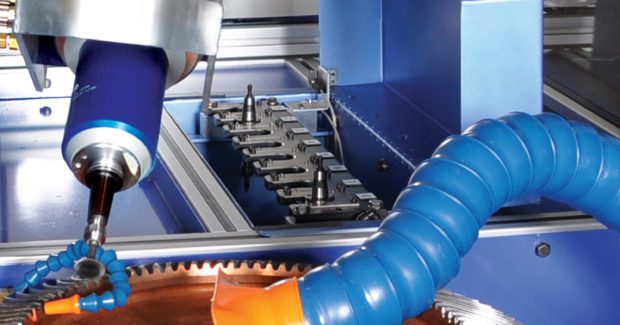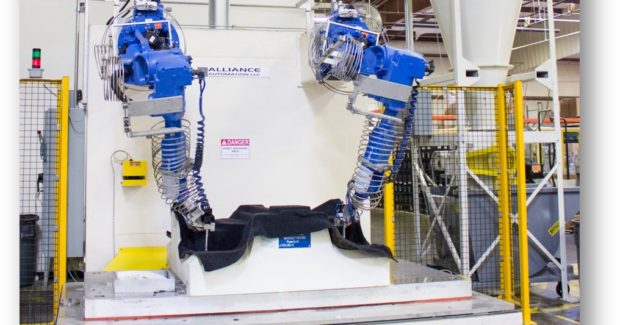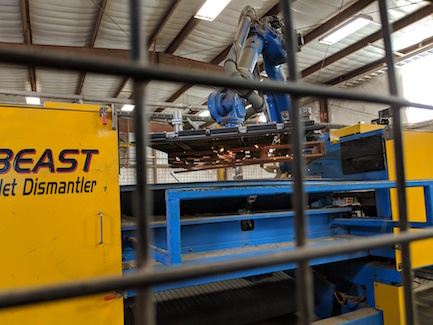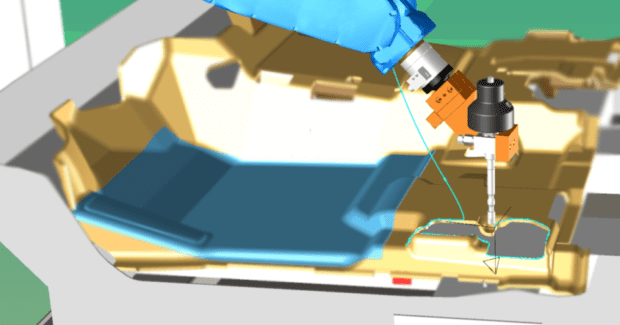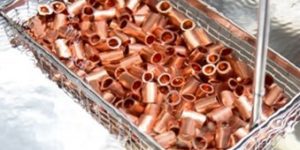An Introduction to Robotic Cutting, Deburring, and Finishing (CDF)
Improvements in finishing tools over the last decade have opened the door to productivity-enhancing automation. Here are solutions manufacturers can confidently implement today.
Posted: March 14, 2020
ADVANCING AUTOMATION COLUMN
BY ROGER CHRISTIAN
Over the past decade, improvements in robotic finishing tools have driven significant growth in the global robotic cutting, deburring, and finishing (CDF) market. As a result, manufacturers that manually perform secondary finishing operations now have viable options for implementing productivity-enhancing automation.
That said, robotic finishing systems are limited primarily to high-volume, low-mix part types because of their high initial capital cost and limitations in system flexibility. Don’t despair, though. The academic community and organizations like the Advanced Robotics for Manufacturing (ARM) Institute are working hard to develop smart and adaptive robotic finishing for high-mix, low-volume manufacturers.
However, I’ll save that discussion for another post. Here, I’ll focus on established and less-known finishing solutions you can confidently implement today.
Proven Robotic Finishing Technology
Grinding and deburring to remove excess material from the surface of cast or machined parts entails a robot bringing parts to a grinder routing tool or sander (part to process) or having the robot manipulate the process tool to a fixtured part (process to part).
Current technology offers little adaptability and flexibility because the robot follows a preprogrammed path. Perfecting the task requires a skilled programmer to spend many hours tweaking the path for each part type. However, once “tuned in,” productivity and quality are assured.
Finishing and polishing. Whether parts are small or large with a complex 3D surface, robots with the appropriate payload and tool can easily follow the surface contour while applying the force required to meet the specification.
As in robotic grinding and deburring, the robot follows a preprogrammed path, limiting its ability to manage part-to-part variations or adapt to diminishing media effectiveness. Small part variations can be managed with active or passive compliance methods.
Laser trimming. While laser cutting is still widely done on CNC machines, technological advancements enable reliable performance with industrial robots, providing manufacturers with cost-effective, space-saving, and maintenance-friendly laser cutting.
A six-axis robot equipped with an active-compliant fiber laser head produces a low-kerf edge. Robotic laser trimming is best suited for formed parts (stamped or molded) 0.5 mm to 4 mm thick.
Plasma cutting. Ideally suited for robots, this method uses high-velocity ionized gas (known as plasma) to melt metals, with the plasma mechanically blowing the molten material away to cut the workpiece.
While part size can vary, plasma cutting is best for trimming thicker metal (3 mm to 30 mm).
Waterjet cutting. Most commonly used to make small holes and other shapes in aluminum, titanium, and all grades of steel, waterjet cutting represents the largest share of the robotic CDF market.
After a high-powered pump (intensifier) sends a stream of water at up to 60,000 psi through a very-small-diameter gem or diamond orifice, fine abrasive material is introduced into the water stream.
Waterjet cutting is used when heat can’t be tolerated in the trimming process. Usually a slow process for 2D part shapes, it’s best suited for CNC gantry machines.
Lesser-Known Robotic Finishing Processes
While the aforementioned cutting and material removal processes are widely used with robots, new applications are being introduced to replace manual processes.
For example, robotic bandsaw pallet dismantling automates a process that’s been done by hand for 100 years. Designed to imitate a human worker’s motion when picking up and moving a pallet through a horizontal bandsaw, robotic bandsaw dismantling streamlines disassembly of wooden pallets ranging from 30 inches by 30 inches to 60 inches by 60 inches.
A six-axis robot with 225-kilogram payload capacity and high-rigidity speed reducers is ideal for such a system. Other peripherals, such as a vacuum pad-style gripper, chain-driven live roller (CDLR) conveyor, and sensor-based measurement system, also facilitate the process.
Dedicated Process Focus
For manufacturers looking for an alternative to waterjet trimming or to replace manual hand trimming, there are new robotic alternatives to consider. Several robotic integrators and OEMs now offer profile routing and scraping tools.
While understanding process variables is critical, it’s also important to be mindful of certain design criteria when choosing a supplier.
Proprietary cutting tools. Blades, routing bits, and scraping tools should be made of high-strength carbide steel instead of run-of-the-mill stainless steel blades. Similarly, tools should be designed for specific applications.
For example, routing tools should include special flute geometry and reverse flute designs to contain dust.
Built-in compliance. Following variable part geometry and managing part shrinkage is extremely important. When necessary, tools that offer inherent compliance can easily accommodate differences such as the variation between part edge and tool path.
Various fixturing methodologies. Depending on the application, parts will need to be held with a certain level of pressure. For example, with waterjet trimming, greater vacuum pressure is required, and proper and proven fixturing is crucial to application success.
Offline programming. Access to a PC-based virtual programming environment is extremely helpful for prototyping and validation processes. Furthermore, the power to create, test, and adjust a robot program accelerates implementation and new part introduction, saving time and lowering costs.
Vast experience with materials. Given rapidly evolving customer demands, it’s ideal to work with a team of experts that understands the nuances and trimming characteristics of a wide swath of materials and textures.





